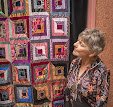New Year - new leaf?

In the customary New Year work-room clear-out I always find large numbers of UFOs, the motivation for some of which entirely escapes me. I’d like to report that I ruthlessly ditch anything I can’t see a use for, but it’s hard …you never know when something may come in for some yet-to-be devised project!
This year, I found a large cache of English patchwork pieces, by which I mean mostly patches tacked over papers ready to be sewn together. It reminded me of how passionate I ‘d been about English patchwork when I first started, nearly 30 years ago. I did use a sewing- machine as well, but it was the fitting together of all those little mosaic pieces by hand that really fascinated me. My first inspiration was, of course, Avril Colby, shortly to be followed by Lucy Boston.
The blue cushion shown was made using the long hexagon template (also known as church window) which Lucy used for her Patchwork of the Crosses. (There is an article about her on my web site which includes a detail from that patchwork.) Using just this one template she created a huge number of different block designs simply by selecting out various pattern elements from the fabrics -what the Americans nowadays call "fussy cutting".I used a border fabric to try to emulate her. Quite a lot of my early patchwork was done in this way, - I was particularly keen on making fabric pictures.
It so happens that my class of ten enthusiastic patchworkers, all keen hand-stitchers, asked particularly to learn English patchwork this month. I'm looking forward to seeing what they make of it, have been working up to now by the American method of piecing. To illustrate the advantages of English patchwork, I've chosen a fairly complex block which has some awkward inset seams, a block which it would be quite possible to make either by machine or by the American hand-sewn method but which, in my opinion, is so much easier to make accurately by English piecing.

No comments:
Post a Comment